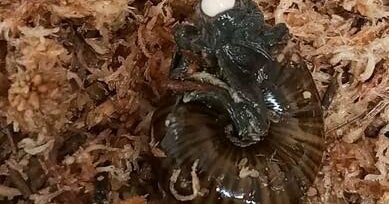

A rare New Zealand snail, the Powelliphanta augusta, has been filmed exhibiting a remarkable reproductive behavior: laying an egg from its neck. This extraordinary event, captured on camera for the first time, offers unprecedented insight into the reproductive strategies of this critically endangered species. The footage shows the snail, a large, dark-shelled specimen, extending a portion of its body from its shell opening. Instead of depositing the egg directly onto the forest floor, as previously assumed, the egg is expelled from a seemingly specialized opening near the base of its neck. Scientists are baffled by this unusual method, noting that it differs significantly from the egg-laying processes observed in other known land snail species. The egg itself is described as remarkably large and translucent, proportionally significant to the size of the snail. The discovery has major implications for the conservation efforts surrounding the Powelliphanta augusta. Understanding the intricate details of its reproductive cycle is crucial to developing successful breeding programs in captivity. This unique egg-laying mechanism necessitates a re-evaluation of current breeding techniques, potentially requiring adjustments to habitat conditions and breeding strategies to better mimic the natural environment and facilitate successful reproduction. Further research is underway to determine the evolutionary origins of this unusual reproductive strategy. Speculation ranges from adaptations for predator avoidance (placing the egg in a less accessible location) to maximizing egg survival in specific microclimates within its forest habitat. The filmed observation serves as a vital piece of the puzzle, highlighting the vast and often-hidden intricacies of the natural world and the urgent need for continued research and conservation efforts to protect vulnerable species like the Powelliphanta augusta. The footage itself is anticipated to be released to the public, providing a glimpse into the remarkable secrets of this unique New Zealand native.

Wellington, New Zealand — The strange reproductive habits of a large, carnivorous New Zealand snail were once shrouded in mystery. Now, footage of the snail laying an egg from its neck has been captured for the first time, the country's conservation agency said Wednesday.
What looks like a tiny hen's egg is seen emerging from an opening below the head of the Powelliphanta augusta snail, a threatened species endemic to New Zealand.
The video was taken at a facility on the South Island's West Coast, where conservation rangers attempting to save the species from extinction have cared for a population of the snails in chilled containers for nearly two decades.
The conditions in the containers mimic the alpine weather in their only former habitat - a remote mountain they were named for, on the West Coast of the South Island, that has been engulfed by mining.
Lisa Flanagan from the Department of Conservation, who has worked with the creatures for 12 years, said the species still holds surprises.
"It's remarkable that in all the time we've spent caring for the snails, this is the first time we've seen one lay an egg," she said in a statement.
Like other snails, Powelliphanta augusta are hermaphrodites, which explains how the creatures can reproduce when encased in a hard shell. The invertebrate uses a genital pore on the right side of its body, just below the head, to simultaneously exchange sperm with another snail, which is stored until each creates an egg.
Each snail takes eight years to reach sexual maturity, after which it lays about five eggs a year. The egg can take more than a year to hatch.
"Some of our captive snails are between 25 and 30 years old," said Flanagan. "They're polar opposites to the pest garden snail we introduced to New Zealand, which is like a weed, with thousands of offspring each year and a short life."
The dozens of species and subspecies of Powelliphanta snails are only found in New Zealand, mostly in rugged forest and grassland settings where they're threatened by habitat loss.
They're carnivores that slurp up earthworms like noodles and are some of the world's largest snails with oversized, distinctive shells in a range of rich earth colors and swirling patterns.
The Powelliphanta augusta was the center of public uproar and legal proceedings in the early 2000s, when an energy company's plans to mine for coal threatened to destroy the snails' habitat.
Some 4,000 were removed from the site and relocated, while 2,000 more were housed in chilled storage in the West Coast town of Hokitika to ensure the preservation of the species, which is slow to breed and doesn't adapt well to new habitats.
In 2011, some 800 of the snails accidentally died in a Department of Conservation refrigerator with faulty temperature control.
But the species' slow survival continues: In March this year, there were nearly 1,900 snails and nearly 2,200 eggs in captivity, the conservation agency said.





